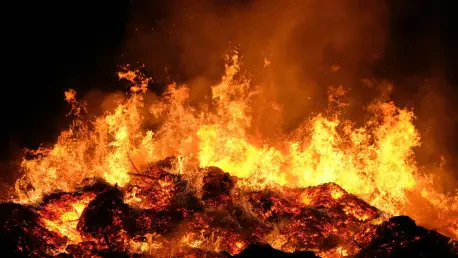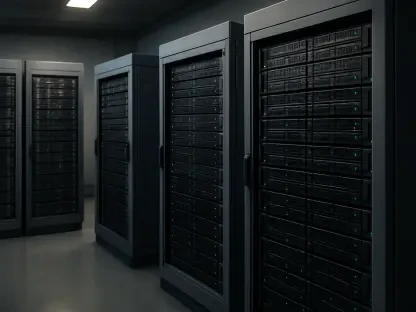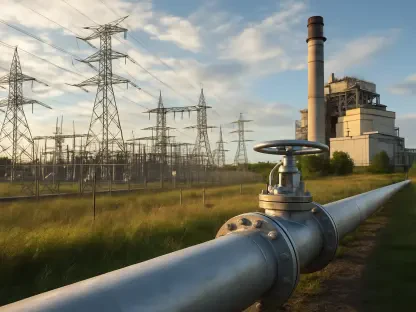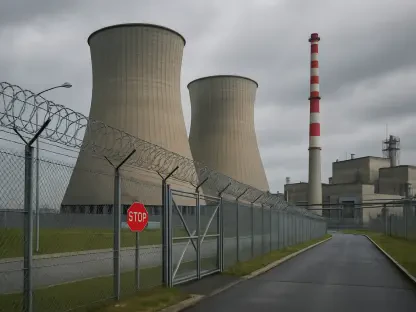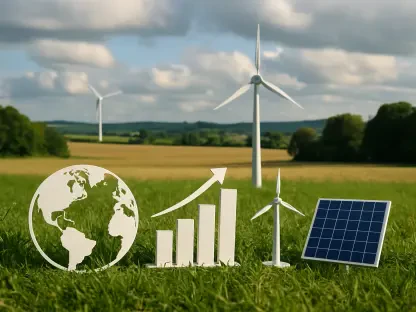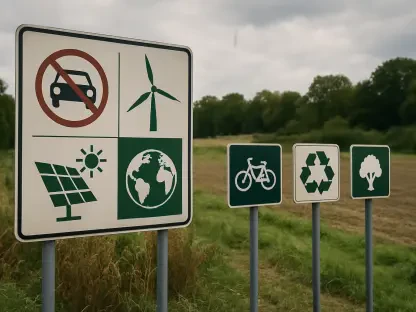Imagine a landscape once rich with rolling hills and vital energy resources now reduced to ash and chaos, as wildfires tear through over 152,000 acres in Rio Blanco County, Colorado, threatening a critical hub of natural gas production in the Piceance Basin. The Elk and Lee wildfires, sparked by lightning strikes on August 2 of this year, have not only scarred the earth but also disrupted an area that supplies 2% to 5% of daily U.S. consumption. This devastating scenario has mobilized a chorus of voices from energy experts, agricultural leaders, state officials, and community advocates. The purpose of this roundup is to gather diverse perspectives on the impact of these fires on energy infrastructure, local livelihoods, and rural connectivity, while exploring actionable solutions for recovery and resilience.
Unpacking the Wildfire Crisis in Rio Blanco County
The scale of destruction in northwestern Colorado has stunned even seasoned disaster response teams, with the Lee fire ranking as the fifth largest in state history. Reports from state emergency management highlight how quickly the flames spread, fueled by dry conditions and high winds, leaving behind a trail of charred land and compromised infrastructure. This crisis extends beyond mere acreage, as it strikes at the heart of a region pivotal to national energy supplies, prompting urgent discussions on how to safeguard such vulnerable areas.
Various stakeholders have weighed in on the immediate priorities following the outbreak. Energy sector analysts emphasize the risk to the Piceance Basin’s natural gas operations, noting that any prolonged disruption could ripple through national markets. Meanwhile, local government officials stress the need for rapid federal intervention to address not just the fires, but also the cascading effects on community well-being and economic stability, setting the stage for a broader dialogue on recovery strategies.
Diverse Perspectives on Impacts and Challenges
Energy Infrastructure Under Siege
Insights from utility operators in the region paint a grim picture of the damage to electric lines managed by local associations, with only a fragile backup line sustaining natural gas production. Industry observers note that the tight gas fields, embedded in dense sandstone and shale, are particularly vulnerable to power outages, leading to instant shutdowns rather than gradual declines. This fragility has sparked debates on whether temporary fixes can hold or if a complete overhaul of infrastructure is necessary.
Contrasting views emerge on the timeline for repairs and the potential fallout for consumers. Some energy consultants argue that swift action could restore operations within months, minimizing impacts on national supply. Others caution that without significant investment, Coloradans might face steep rate hikes, as the cost of emergency measures and long-term rebuilding could strain already tight budgets, highlighting a divide in optimism versus pragmatism.
A third perspective focuses on preventative measures, with suggestions for integrating fire-resistant technologies into future utility designs. Discussions among industry leaders point toward innovations like underground power lines or enhanced monitoring systems to detect fire risks early. This forward-thinking approach, though costly, is seen by many as a critical step to avoid similar crises in the years ahead.
Agricultural Devastation and Economic Strain
Turning to the agricultural sector, rural community leaders describe a heartbreaking loss of grazing and farming lands, with hundreds of acres rendered unusable. Reports circulating among farming associations detail how compromised water quality, tainted by ash and debris, poses immediate threats to livestock health and human consumption. This dual blow has left many producers scrambling to salvage what remains of their operations.
Differing opinions surface on the long-term outlook for food security in the region. Some agricultural experts believe that emergency aid and crop diversification could help mitigate losses over time, offering a glimmer of hope. Others, however, warn of a deeper economic downturn, as the intertwined reliance on farming, oil, and gas in Rio Blanco County means that setbacks in one sector inevitably drag down the others, painting a more somber picture.
Additional input from economic analysts underscores the need for tailored support programs, such as low-interest loans or direct subsidies for affected farmers. These measures, they argue, could bridge the gap until natural resources recover, preventing a mass exodus of rural workers. This perspective adds a layer of urgency to calls for federal assistance, framing agriculture as a linchpin of local stability.
Community Isolation and Safety Risks
The fires, compounded by mudslides from monsoonal rains, have severed vital transportation links, isolating rural residents and hampering emergency access. Community organizers report clogged roads, damaged bridges, and blocked culverts, with some areas cut off for weeks. This physical disconnection has fueled concerns about delivering essential supplies and medical care to those in need.
Safety hazards add another dimension to the crisis, as noted by regional planners who point to hundreds of hazardous trees near public spaces, posing risks of falling during storms or future fires. Opinions vary on how to address these dangers, with some advocating for immediate clearing efforts, while others prioritize rebuilding access routes first, illustrating a tension between short-term safety and long-term connectivity.
Voices from disaster response teams also highlight the psychological toll of isolation on communities, with prolonged separation exacerbating stress and uncertainty. Suggestions for mobile outreach programs to provide mental health support and basic necessities have gained traction among advocates. This human-centered approach contrasts with more structural focuses, broadening the conversation on what recovery truly entails.
Broader Economic and Safety Implications
Beyond immediate damages, the fires threaten the economic fabric of the region, with potential job losses in energy and outdoor recreation sectors looming large. Economic advisors note that disrupted emergency services further compound the issue, as delayed responses could escalate minor incidents into major crises. This interconnected web of challenges has prompted calls for a holistic recovery framework.
Comparative analyses from other wildfire-hit areas offer valuable lessons, with some state officials pointing to successful rebuilding efforts that prioritized multi-sector collaboration. These examples suggest that integrating energy, agriculture, and infrastructure projects under a unified plan can accelerate progress. However, skeptics argue that Colorado’s unique terrain and economic dependencies may require customized solutions, sparking a debate on adaptability versus replication.
A final layer of insight comes from policy experts who speculate on the consequences of delayed federal aid, warning of heightened energy costs and diminished trust in public systems. Their recommendations lean toward proactive lobbying for funding and public-private partnerships to share the financial burden. This strategic angle emphasizes the stakes of inaction, urging stakeholders to act with urgency.
Key Takeaways and Actionable Recovery Steps
Reflecting on the multifaceted insights, the vulnerability of energy infrastructure in the Piceance Basin stands out as a critical concern, alongside widespread agricultural losses and community isolation. Recommendations from various sectors converge on prioritizing federal funding for utility repairs, clearing hazardous debris like fallen trees, and providing emergency resources to farmers. These steps are seen as foundational to stabilizing the region.
Another recurring theme is the importance of community engagement in recovery efforts, with suggestions for local forums to voice needs and monitor aid distribution. Advocates across the board stress that transparency in funding allocation can build trust and ensure resources reach the most affected. This participatory approach offers a practical way to bridge gaps between policy and on-the-ground realities.
Lastly, staying informed on policy developments and supporting grassroots initiatives are actionable ways for broader audiences to contribute. Whether through donations to local relief funds or advocacy for legislative support, public involvement can amplify the impact of official efforts. This collective responsibility underscores the shared stake in rebuilding Rio Blanco County.
Final Reflections on a Path Forward
Looking back, the devastating wildfires in northwestern Colorado revealed stark vulnerabilities across energy, agriculture, and community systems, as diverse voices from industry to local leadership weighed in with urgency. The dialogue captured a spectrum of challenges, from crippled infrastructure to isolated towns, each demanding targeted responses. These discussions laid bare the intricate balance of immediate relief and sustainable planning.
Moving forward, a critical next step involves securing the requested $24 million in federal funding to jumpstart rebuilding efforts, focusing on resilient utility designs and rural access restoration. Exploring innovative partnerships between state agencies and private entities could further alleviate financial strains, ensuring a more robust recovery. These measures aim to not only mend current damages but also fortify the region against future disasters.
Additionally, fostering regional alliances to share resources and expertise could prove transformative, offering a blueprint for other wildfire-prone areas. Encouraging ongoing public awareness and policy tracking ensures that the momentum for change does not wane. These considerations chart a hopeful course, turning a moment of crisis into an opportunity for enduring strength.
